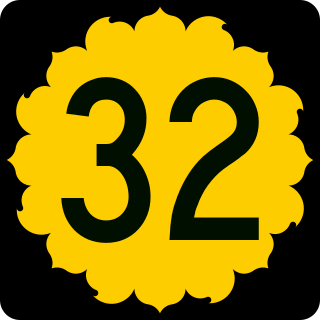
K-32, also known as the Kaw Valley Scenic Highway, is an approximately 32.2-mile-long (51.8 km) east–west state highway in the Kansas City metropolitan area of Kansas. K-32's western terminus is just outside Lawrence at U.S. Route 24 (US-24) and US-40. Its eastern terminus is at US-69, also known as the 18th Street Expressway, in Kansas City. Along the way it intersects several major highways, including K-7 in Bonner Springs as well as Interstate 435 (I-435) and I-635 in Kansas City. In Kansas City, K-32 follows the Turner Diagonal from Kaw Drive to Kansas Avenue. From its western terminus to Bonner Springs, the highway is a two-lane rural highway; the remaining section is a four-lane highway that runs through residential areas.

K-52 is an approximately 23-mile-long (37 km) east–west state highway in eastern Kansas. Its western terminus is at an intersection with K-31 southeast of Mound City. K-52 then overlaps U.S. Route 69 for eight miles (13 km) through Pleasanton and Trading Post, then splits off to the east. three miles (4.8 km) later, it crosses into Missouri, becoming Route 52.
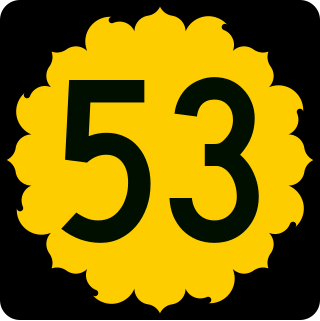
K-53 is a 6.177-mile-long (9.941 km) state highway in the U.S. state of Kansas. Located entirely within Sumner County, K-53's western terminus is at U.S. Route 81 (US-81) south of Wichita and the eastern terminus is at an interchange with K-15 by Mulvane. Along the way, K-53 intersects Interstate 35 (I-35), also known as the Kansas Turnpike, at exit 33. The highway travels mostly through farmlands with the exception of inside Mulvane and is a two-lane road its entire length.

K-55 is a 12.049-mile-long (19.391 km) west–east state highway in the U.S. state of Kansas. The highway's western terminus is at U.S. Route 81 (US-81) roughly 11 miles (18 km) north of Wellington and the eastern terminus is at K-15 in Udall. It passes through the city of Belle Plaine.

K-19 is a 33.915-mile-long (54.581 km) state highway in the U.S. state of Kansas. From U.S. Route 50 (US-50) to K-19 Spur it is signed as north–south and from K-19 Spur to US-281 it is signed as east–west. K-19's southern terminus is at US-50 in Belpre, and the eastern terminus is at US-281 east of Seward.

K-14 is a 219.3-mile-long (352.9 km) north–south state highway which runs through the central part of the U.S. state of Kansas. K-14's southern terminus is at U.S. Highway 160 (US-160) and K-2 in the city of Harper, and the northern terminus is a continuation as Nebraska Highway 14 (N-14) at the Nebraska border by Superior, Nebraska. Along the way it intersects several major east–west highways in the larger cities it passes through, including US-54 and US-400 by Kingman; US-50, K-61 and K-96 by South Hutchinson; K-156 and K-140 by South Ellsworth; Interstate 70 (I-70) and US-40 north of Ellsworth; K-18 in Lincoln; US-24 and K-9 in Beloit; and US-36 east of Mankato. The northern and southern halves of the highway differ fairly significantly in terms of terrain and landscape. The southern half of K-14 travels over fairly flat terrain in the valley of the Arkansas River. Just north of the intersection with K-4 in southern Ellsworth County, K-14 passes into the Smoky Hills region, traveling over a series of broad, rolling hills, providing several scenic vistas of the surrounding countryside. The portion of the highway between Lincoln and Beloit is particularly hilly.
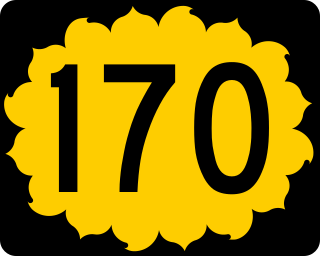
K-170 is a 21.759-mile-long (35.018 km) state highway in the U.S. State of Kansas. K-170's western terminus is at K-99 about 12 miles (19 km) north of Emporia, and the eastern terminus is at K-31 on the west side of Osage City, a mile south of the K-31 intersection with U.S. Route 56 (US-56). K-170 provides access, via county roads, to Lyons County State Fishing Lake.

K-68 is a 61.517-mile-long (99.002 km) east–west state highway in the U.S. State of Kansas. K-68's western terminus is at U.S. Route 75 (US-75) and K-31 south of Lyndon and the eastern terminus is a continuation as Missouri Route 2 at the Missouri state line.
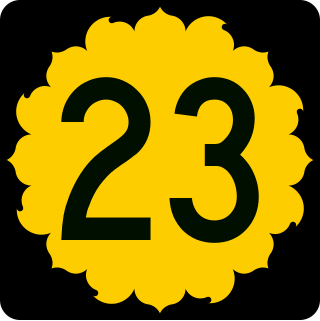
K-23 is a 199.117-mile-long (320.448 km) south–north state highway in the U.S. State of Kansas. It starts as a continuation of Oklahoma State Highway 23 (SH-23) and it runs northward to U.S. Route 83 (US-83) and K-383 near Selden. Along the way it intersects several major east–west highways, including US-54 and US-160 in Meade, US-50 and US-400 in Cimarron, US-56 near Montezuma, K-4 near Healy, and Interstate 70 (I-70) and US-40 south of Grainfield. All but about 1.5 miles (2.4 km) of K-23's alignment is maintained by the Kansas Department of Transportation. The entire section within Cimarron is maintained by the city and a section in Hoxie from Utah Street to Queen Street is maintained by the city.
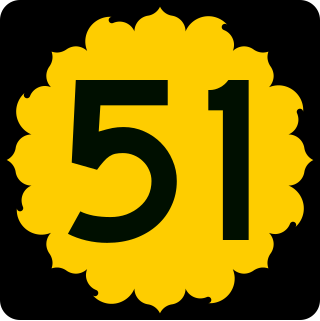
K-51 is an approximately 79-mile-long (127 km) east–west state highway in the southwestern part of the U.S. state of Kansas. K-51 begins at the Colorado state line as a continuation of County Road M and travels eastward through portions of Morton, Stevens, and Seward counties before ending at U.S. Route 83 (US-83) north of Liberal. Along the way, it runs concurrently with US-56 from Rolla to Hugoton. Although K-51 travels through mostly rural farmlands, it does pass through the cities of Richfield, Rolla and Hugoton. The highway is also a two-lane road most of its length with the exception of short sections within Rolla and Hugoton, where it is four lanes.
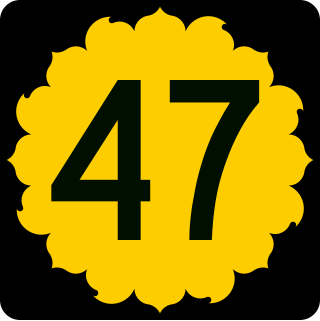
K-47 is an approximately 61.6-mile-long (99.1 km) state highway in the U.S. state of Kansas. It is an east-west route, and connects small towns and cities in southeast Kansas. K-47's western terminus is at the Fredonia city limits, just west of the intersection with U.S. Route 400 (US-400). The eastern terminus is US-69 in Franklin. Along the way, it intersects several major highways including US-75 in Altoona, US-59 south of Erie, and K-7 in Girard. With the exception of the cities K-47 passes through, the highway travels through rural farmland.
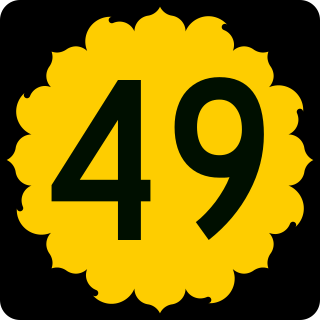
K-49 is a 35.354-mile-long (56.897 km) north–south state highway in the U.S. state of Kansas. K-49 begins at U.S. Route 81 (US-81) in Caldwell, and runs north to K-42 in Viola. Along the way, K-49 has a brief overlap with US-160 south of Conway Springs. The majority of the route exists in Sumner County, with only a mile existing in Sedgwick County.

K-62 is an approximately 13.3-mile-long (21.4 km) state highway in the U.S. state of Kansas. It is a north-south highway that serves towns in the northeastern part of the state. It parallels Soldier Creek for its entire length. K-62's southern terminus is at K-16 west of Holton and the northern terminus is at K-9 southwest of Goff.

K-63 is an approximately 58.8-mile-long (94.6 km) state highway in the U.S. state of Kansas. It is a north–south highway that serves small towns in the northeast part of the state. K-63's southern terminus is at U.S. Route 24 (US-24) in St. Marys and the northern terminus is a continuation as Nebraska Highway 50 (N-50) at the Nebraska border. The highway passes mostly through rural farmlands, however it does pass through the cities of Emmett, Havensville and Corning. It also passes along the edge of Seneca, where it has a short overlap with US-36.
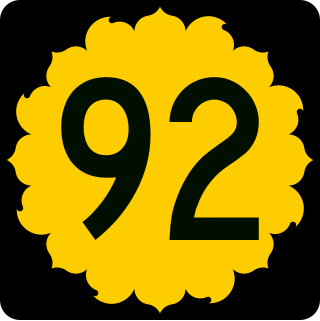
K-92 is an approximately 44-mile-long (71 km) state highway in the U.S. state of Kansas. K-92's western terminus is at K-4 south of the community of Rock Creek, and the eastern terminus is a continuation as Missouri State Route 92 at the Missouri border by the City of Leavenworth. K-92 is co-designated as U.S. Route 59 (US-59) in Oskaloosa, K-16 from Oskaloosa to McLouth, and K-7 and US-73 in Leavenworth. The majority of the route passes through rural farmland and is almost entirely a two-lane roadway, except for the overlap with K-7 and US-73 and a portion of the US-59 overlap, which are four-lane.
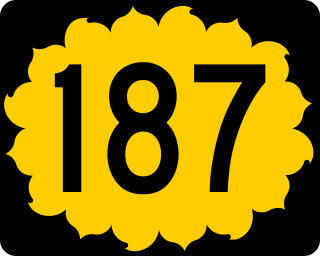
K-187 is an approximately 8-mile-long (13 km) north–south state highway in the U.S. state of Kansas. Located entirely within Nemaha County, K-187 runs from K-9 in Centralia north to U.S. Route 36 (US-36) west of Seneca. The highway passes through grasslands characteristic of the Great Plains and is a two-lane road for its entire length.

K-123 is a 5+1⁄2-mile-long (8.9 km) state highway in the U.S. state of Kansas. The southern terminus is at K-23 north of Hoxie, and the northern terminus is at K-383 in Dresden. Along the way K-123 intersects the western terminus of K-9 south of Dresden.

K-103 is a 6.980-mile-long (11.233 km) east–west state highway located entirely in Cherokee County in the U.S. state of Kansas. K-103's western terminus is at K-7 south of the City of Cherokee and the eastern terminus is at U.S. Route 69 (US-69), US-160 and US-400 south of the City of Pittsburg. Along the way the route passes through the City of Weir.
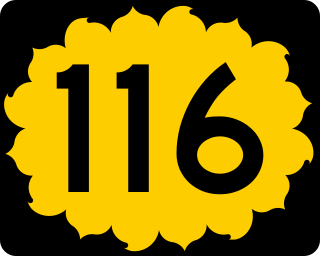
K-116 is a 26.146-mile-long (42.078 km) state highway in the northeast part of the U.S. state of Kansas. K-116's western terminus is at U.S. Route 75 (US-75) and K-16 in Holton, and the eastern terminus is at US-59 southwest of Atchison. The first 3.5 miles (5.6 km) of K-116 is co-designated with K-16. Also a brief section is co-designated with US-159 near the eastern terminus. The highway travels mostly through rural farmland and is a two-lane highway for its entire length.
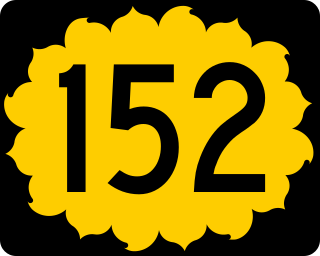
K-152 is an approximately 12.92-mile-long (20.79 km) east–west state highway located entirely within Linn County in the U.S. state of Kansas. K-152's western terminus is at K-7 east of the city of Parker and south of Cadmus, and the eastern terminus is at U.S. Route 69 (US-69) east of the city of La Cygne. The only city that the highway passes through is La Cygne, and it also passes by Prairie View High School west of La Cygne. K-152 is a two-lane road its entire length.






















